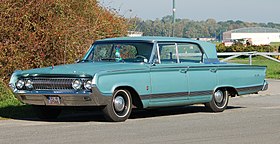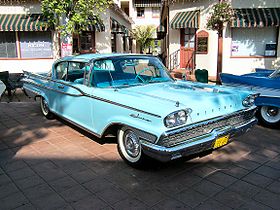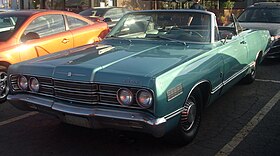Mercury Park Lane
| Mercury Park Lane | |
|---|---|

1964 Mercury Park Lane four-door hardtop (with Breezeway Design roofline)
|
|
| Overview | |
| Manufacturer | Mercury (Ford) |
| Production | 1958–1960 1964–1968 |
| Body and chassis | |
| Class | Full-size |
| Layout | FR layout |
| First generation | |
|---|---|

1959 Mercury Park Lane 2-Door Hardtop Cruiser
|
|
| Overview | |
| Model years | 1958–1960 |
| Assembly |
Metuchen, New Jersey Pico Rivera, California |
| Body and chassis | |
| Body style | 2-door hardtop coupe 2-door convertible 4-door hardtop sedan |
| Layout | FR layout |
| Related |
Mercury Colony Park Edsel Citation |
| Powertrain | |
| Engine | 430 cu in (7.0 l) Ford MEL V8 |
| Dimensions | |
| Wheelbase | 125.0 in (3,175.0 mm) 126.0 in (3,200.4 mm) 128.0 in (3,251.2 mm) |
| Length | 220.2 in (5,593 mm) |
| Width | 81.1 in (2,060 mm) |
| Curb weight | 4,560 lb (2,070 kg) |
| Second generation | |
|---|---|

1967 Mercury Park Lane convertible
|
|
| Overview | |
| Model years | 1964–1968 |
| Assembly |
Hazelwood, Missouri (St. Louis Assembly Plant) Pico Rivera, California (Los Angeles Assembly) Hapeville, Georgia (Atlanta Assembly) |
| Body and chassis | |
| Body style | 2-door Hardtop 2-door convertible 4-door Hardtop |
| Layout | FR layout |
| Powertrain | |
| Engine | 410 cu in (6.7 l) V8 428 cu in (7.0 l) V8 |
| Dimensions | |
| Wheelbase | 120.0–123.0 in (3,048–3,124 mm) |
| Length | 215.0–218.5 in (5,461–5,550 mm) |
| Width | 81.1 in (2,060 mm) |
| Curb weight | 4,171–4,211 lb (1,892–1,910 kg) |
| Mercury Park Lane Brougham | |
|---|---|
 |
|
| Overview | |
| Manufacturer | Ford Motor Company |
| Production | 1967–1968 |
| Body and chassis | |
| Body style | 4-door sedan 4-door hardtop 2-door fastback (1968 only) |
The Mercury Park Lane is a fullsize automobile which was produced by the Mercury division of Ford Motor Company. While not officially introduced as the replacement of the Mercury Turnpike Cruiser, the Park Lane became the flagship of the Mercury model line upon its introduction. The second-generation Park Lane was positioned above the Mercury Montclair.
In 1969 the Mercury Marquis was expanded to a full model line and replaced the Park Lane in the Mercury range.
In 1956, the Park Lane name was used by the Ford division as it created a two-door station wagon intended as a competitor for the Chevrolet Nomad. Based on the Ford Fairlane, the Ford Parklane (spelled as a single word) outsold the Nomad nearly two-to-one, though Ford marketers felt the vehicle had missed its target market; it was discontinued after its only year of production.
The Mercury Park Lane was introduced for the 1958 model year as a premium model line for the division. Available in two-door and four-door hardtop and two-door convertibles, the Park Lane offered the same body styles as the Turnpike Cruiser, though its distinctive "breezeway" rear window was adopted by the Continental Mark line.
Sharing its chassis with the Colony Park station wagon (and Edsel Citation/Corsair), the Park Lane had a 125-inch wheelbase (3 inches longer than the standard Mercury chassis). In 1959, the Park Lane wheelbase was stretched to 128 inches (2 inches longer than other Mercurys). For 1960, the Park Lane wheelbase was again changed, matching the 126 inches of the standard Mercury line.
The Park Lane was powered by a single engine: a 430 cubic-inch Ford MEL V8. Initially rated at 360 hp for 1958, the Super Marauder engine option package allowed any Mercury with the 430 to increase its output to 400 hp (the first mass-production engine in an American automobile to be rated at 400 hp). For 1959, the Super Marauder was discontinued, with the standard engine rated at 345 hp, retuned to 310 hp in 1960. All Park Lanes were equipped with a 3-speed Merc-O-Matic automatic transmission.
...
Wikipedia
